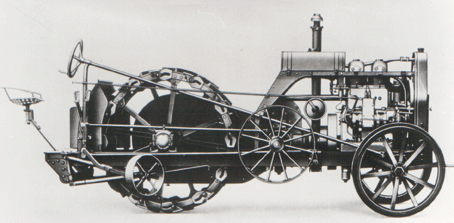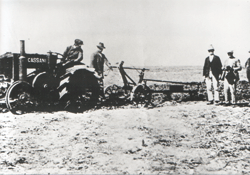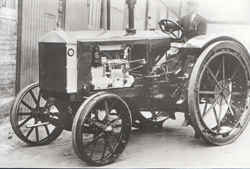Diesel engines – how it all started

Diesel engines are so all-encompassing in agriculture, it’s hard to imagine life without them. Andy Collings looked back at the man who started it all – Rudolf Diesel
While the development of the diesel engine is usually attributed to Rudolf Diesel, there’s always been some dispute as to whether or not he was the true inventor of what is now known as the compression ignition engine.
Herbert Akroyd-Stuart from Halifax first filed a patent for such an engine in 1890, two years before Diesel’s similar engine design was granted a patent. In fact commentators of the day reported that Diesel’s only patentable idea was to increase the compression pressure.
It is a dispute that has rumbled on through the decades. But at the end of the day, it is the name of Diesel that has become the generic term when describing compression ignition engines.

Benz, later part of Daimler-Benz and Mercedes-Benz, developed a twin cylinder diesel engine for trucks in 1921 and also used it in the Benz-Sendling three-wheeled motor plough in 1923.
Diesel was born in Paris in 1858 and was educated in Munich. After he graduated he was employed as a refrigerator engineer.
But he also had a keen interest in engines, an understanding of thermodynamics and a knowledge of the Otto cycle – the four-stroke engine system which revolutionised the workings of the internal combustion engine. His great advance was to design an engine that was not reliant on spark ignition.
Fundamental to Diesel’s design was the fact that when a gas is compressed it becomes hotter. He reasoned that if a cylinder of air was compressed sufficiently – to about 40 bar – it would be hot enough (about 550C) to ignite fuel injected into it.
This ignition would, of course, cause the gas to expand within the cylinder and drive down the piston to turn a crankshaft.
One of the main benefits was to improve the efficiency of the engine and make better use of fuel. Steam engines – the existing technology – were rarely more than 10% efficient, which meant that 90% of the fuel energy was wasted.

Garrett became part of Agricultural & General Engineers (AGE) in 1919. Before going bankrupt in 1932 the company developed a diesel powered tractor considered by many at the time to be the finest in the world. One of the company’s associates was Frank Perkins who went on to achieve great things.
Diesel knew it was impossible for an engine to convert all the energy in the fuel into power. But he calculated that his engine could achieve an efficiency of at least 75% – vastly higher than any other engine in the world.
There was also the potential advantage that the new engine wouldn’t be plagued with electrical problems or need distributors and spark plugs.
Designing the diesel engine appeared, on paper, to be reasonably straightforward but putting it in to practice proved rather more difficult.
For a start, never before in the history of engines had such high pressures or temperatures been attempted. Getting piston seals to work properly was particularly difficult, as was getting fuel into a cylinder that was under so much pressure.
By 1893 the first experimental engine had been built in Augsberg, Germany, in collaboration with a company called Maschinenfarik Augsberg (MAN). It was not a big success – its power output was said to little more than the donkey engine used to turn the engine over.
By any standards, this engine was big. It used a 3m (10ft) diameter iron cylinder and had a large flywheel at its base. It ran at about 100 rpm – not much different from the steam engines it would ultimately replace.
It was not a convincing start and one made all the worse when the engine self-destructed – its construction clearly not up to the severe pressures created.
A second engine was built in 1896 with several improvements gleaned from the earlier design. It now had water cooling and ringed pistons and managed an efficiency of 25%. Power output was 18hp at 154rpm.
But there were still problems. The compression pressure of 30bar was below the level Diesel had hoped for and, while work progressed to improve this important detail, there remained the problem of fuel injection.

Marshall began building diesel tractors in 1929. This 18-30 model appeared in 1930 with the distinctive horizontal single cylinder diesel engine on board – versions were available up to 1957.
To get fuel into the cylinder, a high pressure air injection system was used that “hurled” fuel droplets into the cylinder. It was complicated and involved expensive components and it was fraught with reliability problems. It was also limited to engine speeds to little more than 250rpm.
Diesel never resolved the fuel injection problems satisfactorily. It took another 20 years before a system was developed that could pump and disperse measured amounts of fuel into a highly pressurised cylinder without the use of air.
Even so, the advantages the new compression ignition engine could offer the world as an alternative to the steam engine were soon recognised.
Diesel’s engines were built by numerous manufacturers keen to take a slice of this new business and used to power a wide number of applications – generators, pumps, trucks and so on. But it was not until 1927 that the first diesel-powered agricultural tractor was built by Franceso Cassani, the founder of the Same tractor business.
Diesel was also a better engineer than businessman. Plagued by endless patent disputes and the persistent demands of unscrupulous businessmen, Diesel eventually lost the rights and the control of his invention – and the ability to make further improvements.
Only in 1908, when his patents had expired in Europe (1912 in the USA) was he able to apply his skills to the development of smaller engines which could be used in trucks and automobiles.
A combination of poor investments and bad financial advice soon left Diesel with severe money problems. In addition, it was said that he had suffered mentally from the stresses and strains caused by endless hours and years of testing and development.
The end came on 29 September, 1913 when Diesel boarded a steamer in Antwerp to make the night crossing to Harwich to attend an engineering meeting. Some time during the night he disappeared overboard, his body being found several days later. It was thought that he had taken his own life.
Development of the diesel engine has continued over the decades to make it the reliable, efficient, clean-burning unit we are now all familiar with.
In many ways the compression ignition engine was the culmination of a host of earlier developments – the Otto cycle, the Carnot cycle and the understanding of thermodynamics, to name but three. But it took the visionary genius of Rudolf Diesel to put them all together and create what we now know to be the diesel engine.

